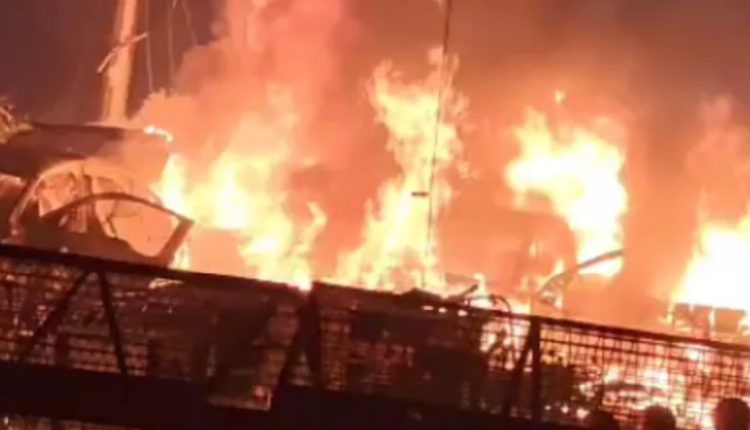By Suresh Unnithan ,with input from Nanditha S
New Delhi: The horrific car explosion near the iconic Red Fort on November 10, 2025, which killed at least 13 people and injured over 20 others—many still battling for their lives—has plunged the nation into mourning and heightened alert. As investigators comb through debris and newly surfaced CCTV footage showing the Hyundai i20 erupting in flames at a traffic signal around 6:52 PM, the attack lays bare a sinister truth: sleeper cells affiliated with Islamic terror outfits like Jaish-e-Mohammed (JeM) are entrenched within India’s society, often hiding behind facades of respectability, including among educated professionals such as doctors.
Prime Minister Narendra Modi, who returned from Bhutan to visit survivors at LNJP Hospital on November 12, reiterated his vow that “those responsible will not be spared,” emphasizing swift justice. The National Investigation Agency (NIA) has taken over the probe, uncovering links to a sophisticated “white-collar” terror module involving Kashmiri doctors trained at institutions like Al-Falah University in Faridabad—though the university has denied any involvement or storage of chemicals on campus. Key breakthroughs include the seizure of 2,900 kg of ammonium nitrate explosives, timers, and rifles from a suspect’s residence in Faridabad, and revelations that two accused doctors met JeM handlers in Turkiye. Intelligence sources now suspect the blast may have been a panicked execution of a larger plot targeting Republic Day on January 26, foiled partially by recent arrests, including one in Saharanpur for pro-JeM posters. No traces of RDX have been found yet, but the vehicle-borne improvised explosive device (IED) underscores the evolving lethality of these networks.
This tragedy at the 17th-century Mughal fortress—a prestigious symbol of India’s sovereignty where the Prime Minister hoists the national flag every August 15 on Independence Day—is no standalone horror. It echoes a dark legacy of assaults, from the 2001 Parliament attack to the 2008 Mumbai siege, calling for introspection beyond partisan blame: a robust, unified intelligence framework is imperative to dismantle these shadows.
Data from the South Asia Terrorism Portal (SATP) paints a stark picture: Islamist terror incidents in India since 2000 have claimed over 25,000 lives, including more than 8,000 civilians, 4,000 security personnel, and the remainder militants, with tens of thousands wounded. In Jammu and Kashmir, the epicentre of such insurgency, over 20,000 deaths have been recorded from 2000 to 2024, a testament to the enduring scourge of Pakistan-backed jihadism. Landmark events like the Parliament breach (nine killed, 18 injured) and the 26/11 Mumbai attacks (166 dead, over 300 injured) illustrate a trajectory of brazen, high-impact operations that have left indelible scars.
Eyewitness accounts from the bustling evening rush near the monument remain gut-wrenching: “The blast was so loud it felt like the sky cracked open; body parts scattered everywhere,” one survivor recounted, voice breaking amid the chaos of flaming vehicles and screams. Preliminary findings suggest a suicide bombing, with the alleged perpetrator identified as Dr. Umar Nabi, a Kashmiri doctor tied to JeM’s radical networks and part of a module of at least six medical professionals radicalized over years. This infiltration by “white-collar” terrorists—doctors who leveraged their credentials for cover—revives nightmares of societal subversion, where expertise masks extremism.
History offers grim precedents. The Red Fort itself was targeted on December 22, 2000, when Lashkar-e-Taiba (LeT) snipers gunned down three soldiers amid Republic Day preparations, signaling early cross-border threats. This was swiftly followed by JeM and LeT’s 2001 Parliament storming, which teetered the region toward war and exposed security chinks. The 2008 Mumbai rampage, a 60-hour LeT fidayeen assault on hotels, a station, and a Jewish center, claimed 166 lives, orchestrated from Pakistani havens with sleeper agents—merchants, students, families—facilitating logistics undetected.
Veteran voices amplify the urgency. A former Intelligence Bureau Special Director, scarred by counter-terror battles, laments the chasm between intel leads and action: “There was some intelligence input… but it couldn’t be translated into actionable intelligence for ground security.” He pushes for “massive thrust to covert action” and “kinetic operations” post-strikes, stressing pre-emption with global support against state-sponsored terror.
Echoing this, former Jammu and Kashmir Director General of Police (DGP) S.P. Vaid, drawing from decades combating Valley modules, identifies the Red Fort blast as a compromised JeM plot executed in haste by a suicide bomber after arrests unravelled the network. He traces its Kashmir roots to ISI-orchestrated radicalization of ambitious youth—doctors funded for MBBS and embedded in cities like Delhi and Haryana—turning “the enemy within” against the nation. Vaid warns of weapon smuggling via fruit trucks and cross-border financing, urging immediate multi-agency coordination (Delhi Police, NIA, NSG) to map money trails and dismantle handlers. His recommendations include full-body scanners at border checkpoints like Lakhanpur to inspect vehicles, relentless vigilance against radicalization in hotspots (UP, Kerala, Bengal), and targeted strikes on Pakistan’s ISI and army to cripple groups like JeM before they export more carnage. “Guards cannot be lowered; hinterland attacks have surged since 2014—counter the ideology at its source,” he asserts.
The roadmap ahead demands fortification: Enhance the Multi-Agency Centre (MAC) for seamless intel fusion, deploy AI for dark web surveillance and UAPA-tracked financial probes, and bolster human networks in vulnerable enclaves. Community ties with moderate voices can starve recruitment, while Vaid’s call for tech-enabled checks and Azad’s deterrence via ops form a layered shield. High alerts now blanket metros like Mumbai and Lucknow, but sustained reform is key.
In conclusion, the Red Fort’s desecration tests India’s unyielding spirit, but it must ignite resolve. To the lurking sleeper cells: Your shadows will be exposed, your networks uprooted—no white coat or elite veneer shields you from justice. Intelligence and security agencies, sharpen your edge—translate whispers into walls of prevention, lest complacency invite more blood. Politicians, transcend rhetoric for resources: Fund the watchmen, unify the front, or risk history’s harshest verdict. This is no mere blast; it’s a summons to vigilance. India endures through unity—let this clarion ensure the next dawn breaks terror-free.


